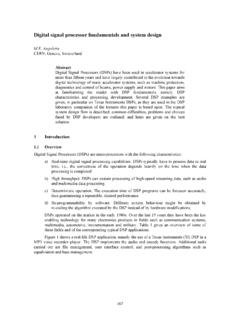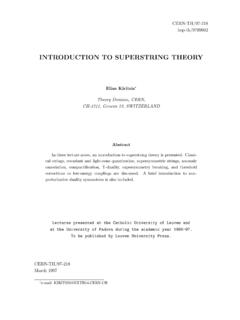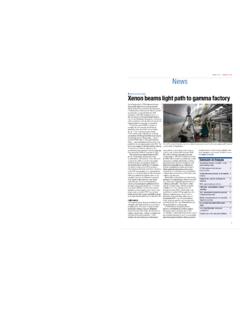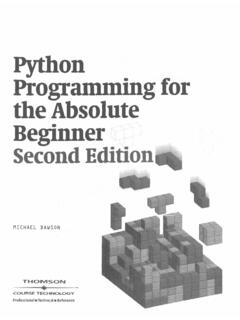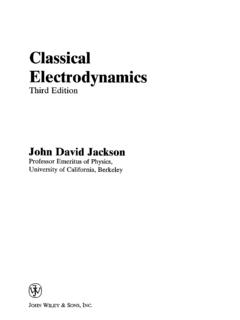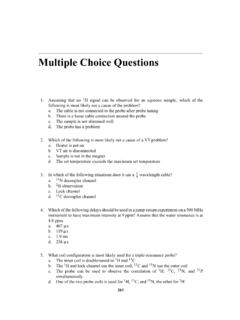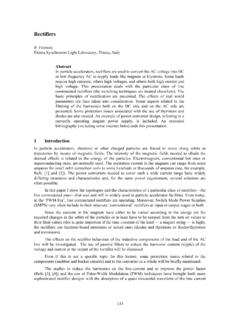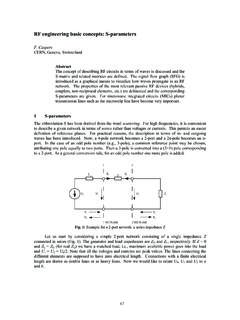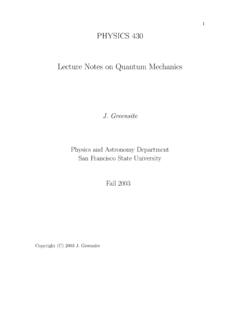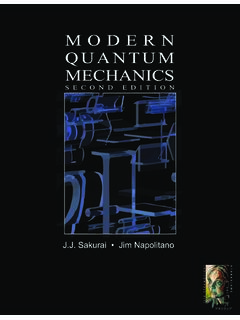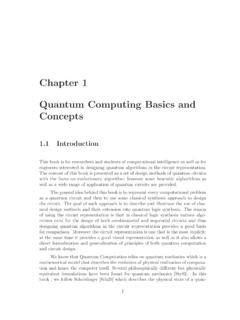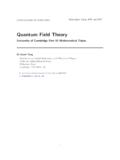Transcription of ON THE EINSTEIN PODOLSKY ROSEN PARADOX*
1 Physics Vol. 1, No. 3, pp. 195-290, 1964 Physics Publishing Co. Printed in the United States ON THE EINSTEIN PODOLSKY ROSEN paradox * ]. S. BELLt Department of Physics, University of Wisconsin, Madison, Wisconsin (Received 4 November 1964) I. Introduction THE paradox of EINSTEIN , PODOLSKY and ROSEN [1] was advanced as an argument that quantum mechanics could not be a complete theory but should be supplemented by additional variables. These additional vari-ables were to restore to the theory causality and locality [2]. In this note that idea will be formulated mathematically and shown to be incompatible with the statistical predictions of quantum mechanics . It is the requirement of locality, or more precisely that the result of a measurement on one system be unaffected by operations on a distant system with which it has interacted in the past, that creates the essential dif-ficulty.
2 There have been attempts [3] to show that even without such a separability or locality require-ment no "hidden variable" interpretation of quantum mechanics is possible. These attempts have been examined elsewhere [ 4] and found wanting. Moreover, a hidden variable interpretation of elementary quan -tum theory [S] has been explicitly constructed. That particular interpretation has indeed a grossly non-local structure. This is characteristic, according to the result to be proved here, of any such theory which reproduces exactly the quantum mechanical predictions. II. Formulation With the example advocated by Bohm and Aharonov [6], the EPR argument is the following. Consider a pair of spin one-half particles formed somehow in the singlet spin state and moving freely in opposite directions.
3 Measurements can be made, say by Stern-Gerlach magnets, on selected components of the Spins d l and a 2, If measurement Of the component d I 'a, where a is some unit vector, yields the value + 1 then, according to quantum mechanics , measurement of a2 a must yield the value -1 and vice versa. Now we make the hypothesis [2], and it seems one at least worth considering, that if the two measure-ments are made at places remote from one another the orientation of one magnet does not influence the result obtained with the other. Since we can predict in advance the result of measuring any chosen compo-nent of a2, by previously measuring the same component of d 1, it follows that the result of any such measurement must actually be predetermined.
4 Since the initial quantum mechanical wave function does not determine the result of an individual measurement, this predetermination implies the possibility of a more complete specification of the state. Let this more complete specification be effected by means of parameters A. It is a matter of indiffer-ence in the following whether A. denotes a single variable or a set, or even a set of functions, and whether the variables are discrete or continuous. However, we write as if A were a single continuous parameter. The result A of measuring a 1 a is then determined by a and A., and the result B of measuring 7, 2 b in the same instance is determined by b and A., and *Work supported in part by the Atomic Energy Commission tan leave of absence from SLAC and CERN 195 196 ].
5 S . BELL Vol. 1, No. 3 A (l:i, ,\) = 1, B (b, ,\) = 1. (1) The vital assumption [2] is that the result B for particle 2 does not depend on the setting ;;, of the magnet for particle 1, nor A on b. If p (,\) is the probability distribution of ,\ then the expectation value of the product of the two com-~ ~ ~ 7 ponents o1 a and o2 D is P (t;, b) = .fn p (,\)A (~, ,\) B (b, ,\) (2) This should equal the quantum mechanical expectation value, which for the singlet state is (3) But it will be shown that this is not possible. Some might prefer a formulation in which the hidden variables fall into two sets, with A dependent on one and B on the other; this possibility is contained in the above, since ,\ stands for any number of vari-ables and the dependences thereon of A and B are unrestricted.
6 In a complete physical theory of the type envisaged by EINSTEIN , the hidden variables would have dynamical significance and laws of motion; our ,\ can then be thought of as initial values of these variables at some suitable instant. 111. 111 us trot ion The proof of the main result is quite simple. Before giving it, however, a number of illustrations may serve to put it in perspective. Firstly, there is no difficulty in giving a hidden variable account of spin measurements on a single particle. Suppose we have a spin half particle in a pure spin state with polarization denoted by a unit -> _. vector p. Let the hidden variable be (for example) a unit vector ,\ with uniform probability distribution over the hemisphere A p > 0.
7 Specify that the result of measurement of a component ; ;; is -> -> I sign ,\ a , (4) where -.;i is a unit vector depending on ~ and p in a way to be specified, and the sign function is + 1 or -1 according to the sign of its argument. Actually this leaves the result undetermined when ,\ a' 0, but as the probability of this is zero we will not make special prescriptions for it. Averaging over ,\ the expectation value is < ; ~ > = 1 - 2 e' Irr , (5) where ()1 is the angle between t;' and p. Suppose then that "ii' is obtained from ; by rotation towards P until 2 ()' 1 -TT cos () -> -> where () is the angle between a and p. Then we have the desired result < ; . ;; > = cos () (6) (7) So in this simple case there is no difficulty in the view that the result of every measurement is determined by the value of an extra variable, and that the statistical features of quantum mechanics arise because the value of this variable is unknown in individual instances.
8 Vol. 1, No. 3 ON THE EINSTEIN PODOLSKY ROSEN paradox 197 Secondly, there is no difficulty in reproducing, in the form (2), the only features of (3) comm only used in verbal discussions of this problem: (.. (.. P a, a) = -P a, -a) = -1 l P <a, b) = o if ;; . 1i = o ~ (8) For example, let A now be unit vector A, with uniform probability distribution over all directions, and take This gives A(a, A)= sign a. A t B (a, b) = -sign b A \ P <a, b) = -1 + 3. e , Tr (9) (10) where e is the angle between a and b, and (10) has the properties (8). For comparison, consider the re-sult of a modified theory [6] in which the pure singlet state is replaced in the course of time by an iso-tropic mixture of product states; this gives the correlation function (11) It is probably less easy, experimentally, to distinguish (10) from (3), than (11) from (3).
9 Unlike (3), the function (10) is not stationary at the minimum value -l(at e = 0). It will be seen that this is characteristic of functions of type (2). Thirdly, and finally, there is no difficulty in reproducing the quantum mechanical correlation (3) if the results A and B in (2) are allowed to depend on b and a respectively as well as on a and b. For ex-ample, replace a in (9) by a', obtained from a by rotation towards b until 2 I 1 --e = cos e, Tr where e' is the angle between a' and b. However, for given values of the hidden variables, the results of measurements with one magnet now depend on the setting of the distant magnet, which is just what we would wish to avoid. IV.
10 Contradiction The main result will now be proved. Because p is a normalized probability distribution, /d>..p(A.) = l, (12) and because of the properties (1), p in (2) cannot be less than -1. It can reach - 1 at a = b only if A (a, >..) = -B (a, A) except at a set of points A of zero probability. Assuming this, (2) can be rewritten P(a, b) = -fa>..p(A.) A(a, A) A(b, A). (13) (14) 198 ]. S. BELL It follows that c is another unit vector using (1), whence P(a, b) -P(;, c) = (A) [A(a, A) A(b, A) -A(a, A) A(c, ,\)) = fi1i. p (A) A (a, ,\) A (b, ,\) [A (b, ,\) A (c, ,\) -1) 1 P(a, "h) -P(a, c) 1 s f<np(,\) [1-A(b, ,\) A(c, 1i.)J The second term on the right is P (b, c), whence 1 + p <"h, c) 2 1 P <a, 6) -P <a, c) 1 Vol.]]
